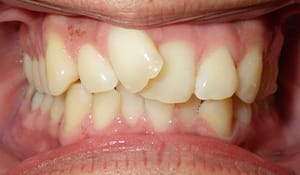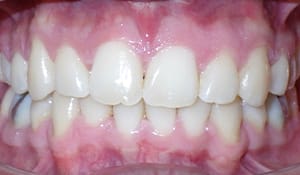Home - All About Braces - How to Know If You Need Braces - Crowded Teeth

Erick practices orthodontics in our Riverton Oral Health office.
Crowded Teeth
What Are Crowded Teeth, Why They Happen, and When Braces Might Be Needed.


Teeth crowding is one of the most common reasons orthodontists recommend braces. It happens when there’s not enough space in the mouth for permanent teeth to come in properly. As a result, teeth can overlap, twist, or erupt in the wrong places, making smiles look uneven and making daily hygiene more difficult.
What Causes Crowded Teeth?
- A jaw that’s too small to fit all the adult teeth
- Early or late loss of baby teeth
- Extra teeth or unusually large teeth
- Thumb sucking or prolonged pacifier use
- Teeth shifting after tooth loss or trauma
Why Is Teeth Crowding a Problem?
Crowded teeth don’t just affect appearance — they can impact long-term oral health. When teeth overlap or twist, it becomes harder to brush and floss effectively. This can lead to:
Cavities and gum inflammation
Plaque buildup in hard-to-reach areas
Uneven wear on tooth enamel
Bite problems or jaw discomfort
Left untreated, crowded teeth can worsen over time, making future treatment more complex.
How Do I Know If My Child Has Crowded Teeth?
- Overlapping or crooked front teeth
- Teeth that seem rotated or pushed back
- Baby teeth falling out too early or too late
- Adult teeth erupting behind others or in unusual positions
- Speech issues or difficulty chewing certain foods
How Are Crowded Teeth Treated?
Mild crowding may only require simple orthodontic adjustments. In more significant cases, treatment might include:
- Traditional metal braces or ceramic braces
- Clear braces like Clarity Advanced or aligners like Invisalign (for teens and adults)
- Arch expanders or space maintainers
- Tooth extraction (in rare cases)
Our orthodontic team uses high-resolution imaging to evaluate each case and create a treatment plan that fits your child’s needs, age, and long-term goals.
When Should I Schedule a Consultation?
The American Association of Orthodontists recommends a first screening around age 7 — even if all baby teeth haven’t fallen out. Early detection of crowding can make a big difference in how simple (or complex) treatment will be later.
We offer complimentary orthodontic consultations for children, teens and adults. You’ll get imaging, expert insights, and a personalized plan — no pressure, no commitment.
Claim Your Complimentary Consultation
Our orthodontic team is here to help with complimentary orthodontic consultations in Bluffdale, Riverton, Stansbury Park, and West Jordan.
Complete the form below or call (801) 254-9700 to schedule.
Frequently Asked Questions
Can teeth crowding fix itself as my child grows?
What happens if crowded teeth are left untreated?
Crowding can lead to tooth decay, gum disease, jaw pain, and bite issues over time. It may also become more difficult (and expensive) to treat later.
Can Invisalign fix crowded teeth?
Yes, clear aligners like Invisalign can often treat mild to moderate crowding. Severe cases may still require braces.
Is crowding always caused by genetics?
How long does it take to fix crowded teeth?
Most orthodontic treatments for crowding take between 12 to 24 months, depending on severity and the chosen method.